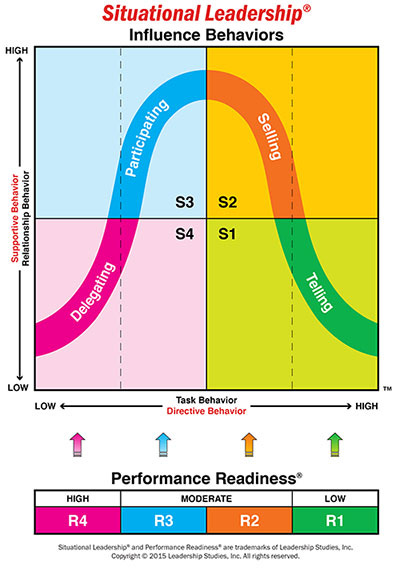Spread your wings and prepare to fly
Utilizing Situational Leadership to meet your reports where they are
Being a manager is a difficult task, and not everyone is cut out for it. Even if you are, it can be tough at the beginning as you navigate the needs of your team. You may have questions such as: Where do you start? How do you treat everyone fairly? How can you help them grow? These are common concerns for new managers and even experienced ones.
Becoming an effective manager takes time and experience, but there are leadership frameworks that can help you be more effective. One of the most helpful frameworks I’ve come across in my career is Situational Leadership.
Situational Leadership is based on the idea that effective leaders meet their team members where they are in their career or evolution. Every team member has unique needs and different levels of readiness, and to be effective, a manager needs to be aware of those needs and levels of readiness and address them accordingly. The Situational Leadership framework identifies four different styles depending on the readiness of the team member. Readiness is determined by the team member's level of competence and commitment to a task or goal.
The four styles are:
Telling/Directing (micro-managing) - This style is appropriate for team members who are low in competence but high in commitment. It involves providing specific instructions and closely supervising the team member's work.
Selling/Coaching (help me, I’ve never done this before) - This style is appropriate for team members who are low to moderate in competence but low in commitment. It involves providing guidance and support to help the team member further develop their skills and build confidence around a task.
Participating/Supporting (be my sounding board) - This style is appropriate for team members who are moderate to high in competence but variable in commitment. It involves providing support and encouragement, empowering the team member to take ownership of their work.
Delegating (you got this, keep me informed) - This style is appropriate for team members who are high in competence and commitment. It involves providing minimal guidance and support, trusting the team member to take full responsibility for their work.
Every team member finds themselves at different levels of the Situational Leadership framework throughout their career. Typically when a report is in the “Delegating” level, they are very close to being promoted. Once promoted, they typically go right back to “Telling/Directing”. There’s no reward for being in a certain level. It simply helps a manager identify where someone is and how to best support them.
How do I implement this?
Identify
To implement this framework effectively, start by identifying what level each of your team members is at. Think through when they were promoted or when they started and how prescriptive you need to be when directing them to do a task. Be critical and honest with yourself and your report.
Unless you manage a team of entry-level individuals, if you find that all of your reports are at “Telling/Directing”, the issue might be you. Question whether you need to be as prescriptive as you are with your team and push yourself to back off a bit with some reports to see how it goes. Rinse and repeat until you have a more balanced distribution of levels across your reports.
Communicate
I like to communicate my management approach to my team members during our initial meetings. Although I may not explicitly state that I am using Situational Leadership as my framework, I make it clear that my goal is to meet them where they are and have an open discussion about their role. I inform them that I may be more prescriptive at the beginning and then gradually back off as we build trust and they become more comfortable in their role. It is important to be transparent with your team members about the behaviors you expect from them to help them progress to the next level.
Initially, I had difficulty with micro-managing my team members as I do not appreciate being micromanaged myself. However, to set up your team members for success, you must provide them with the appropriate scaffolding and then step back gradually. I think of this process like learning to ride a bike. You start with training wheels, but eventually, you must learn to balance the bike on your own. As a manager, you are the training wheels. However, this phase should not last for more than a few months. If you find that it is taking longer than this, it may be a sign of a performance issue that needs to be addressed. Alternatively, you may need to evaluate whether you are enabling the behavior in any way.
Revisit
In my experience, everyone begins at the "Telling/Directing" level when starting a new role, but the speed at which individuals progress through the various levels can differ based on their unique skillsets and experience. This applies to all individuals in the organization, regardless of their position, as everyone will encounter tasks that they have never done before, and their level of competence may require more guidance from their manager.
To ensure that you are meeting your team members where they are, it is essential to revisit the different levels regularly. At a minimum, this should be done quarterly, but ideally, it should be a monthly occurrence. By revisiting these levels, I do not mean conducting a lengthy process, but rather taking just five minutes to reflect on your team members' progress and identify the level they might be at.
It takes two to tango
Remember, it takes two to tango. The onus of identifying what level a team member is in does not only fall on the manager, but also on the team member themselves. Through candid conversations, you can align on expectations and what it takes to continue to grow. This makes performance conversations much easier as no one is surprised by where they stand and what’s expected of them.
That isn’t fair
Being fair as a manager does not mean managing everyone the exact same way. It means treating everyone with the same respect and giving them the same opportunities depending on their level of competence and readiness. It means equally setting them up for success by meeting them where they are at and expecting the same from everyone at the same level.
Spread your wings and prepare to fly
Mariah Carey said it best in her 1997 hit “Butterfly”:
Spread your wings and prepare to fly
For you have become a butterfly…
Your goal as a manager is to prepare your team members to fly. This requires you to come up for air every so often to think through the readiness of your team to take flight, acknowledging that sometimes they will be ready, but will need to come back to the nest to pick up new skills.
Give Situational Leadership a shot and let me know how it goes. If I can be of help in discussing this framework further or thinking through where your reports fall in the spectrum of levels, don’t hesitate to give me a shout.





In my opinion, if your team sees you fly, they will know how to fly when they are ready to do it. Example is a fundamental element in leadership.
Congratulations for this post